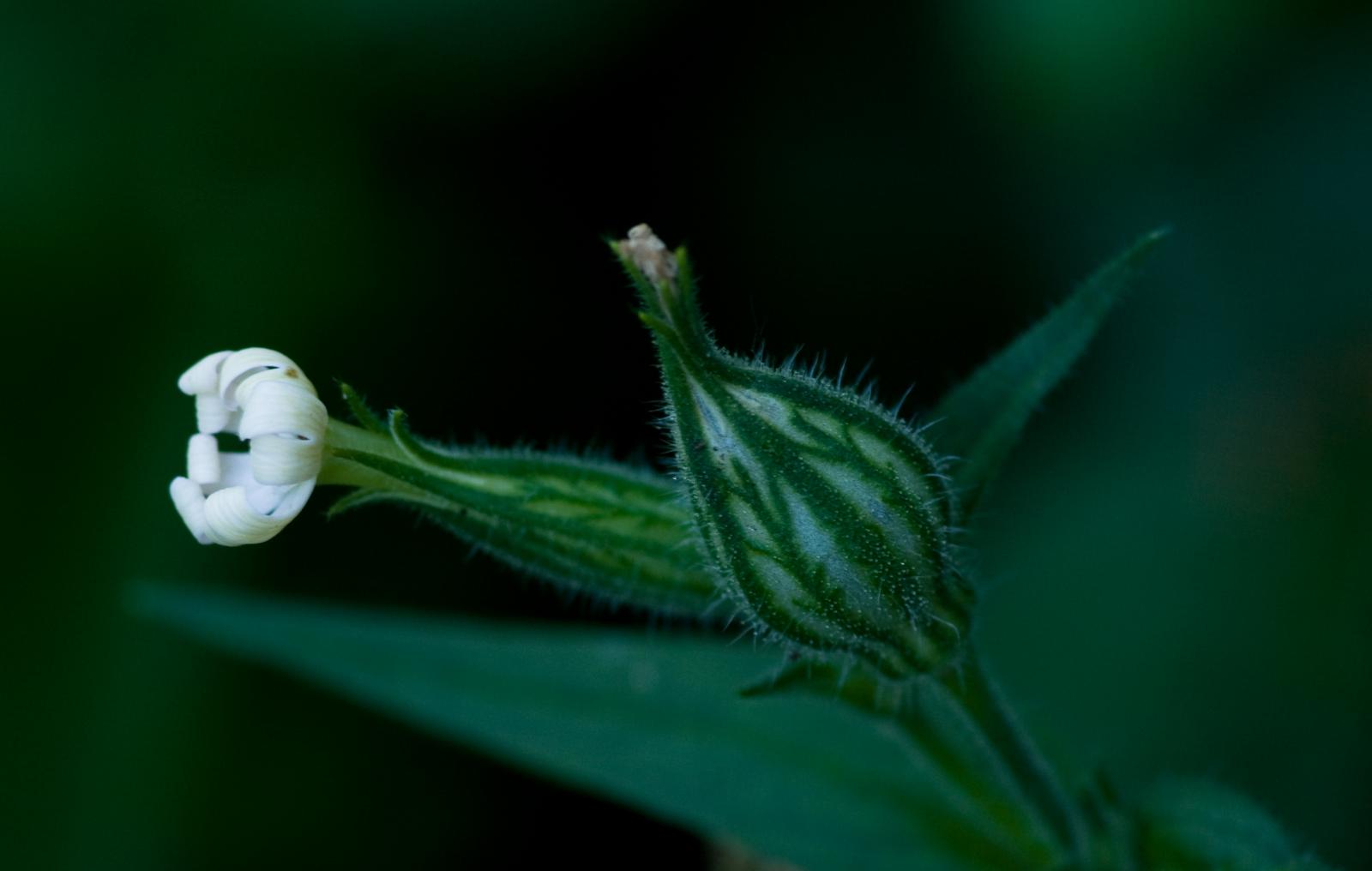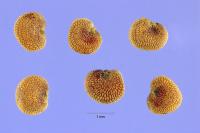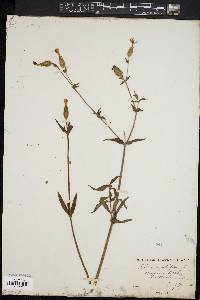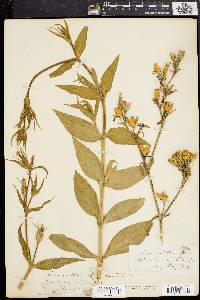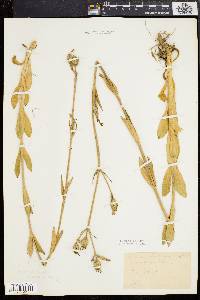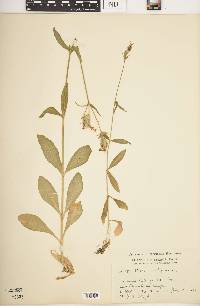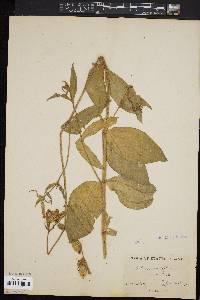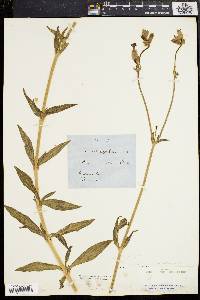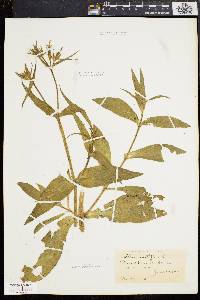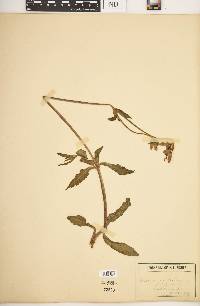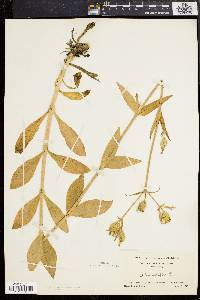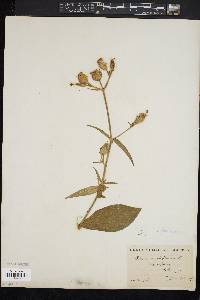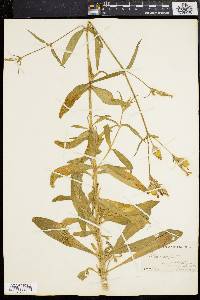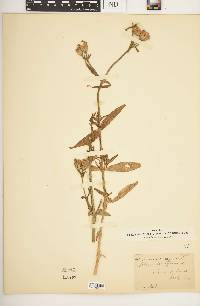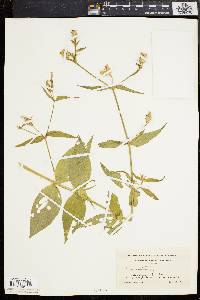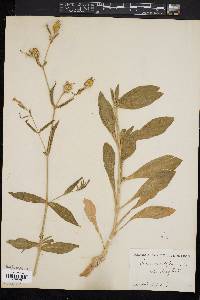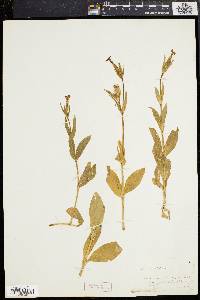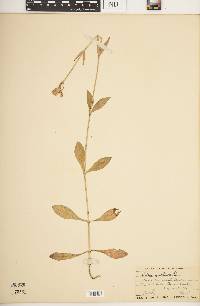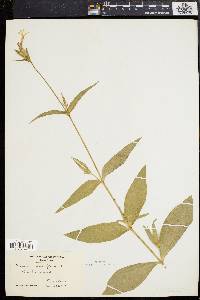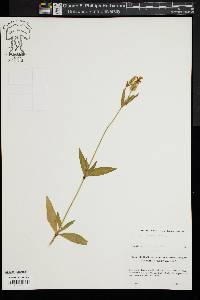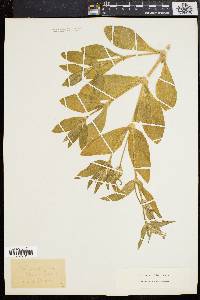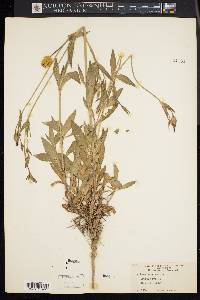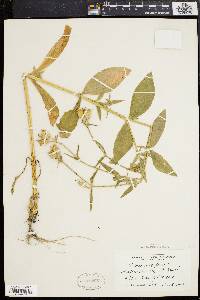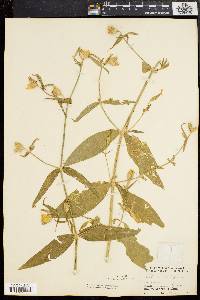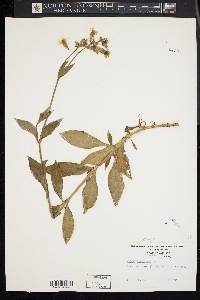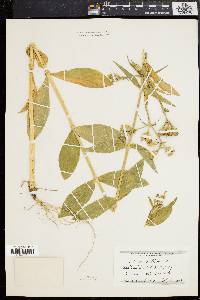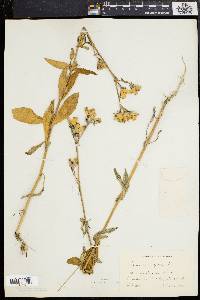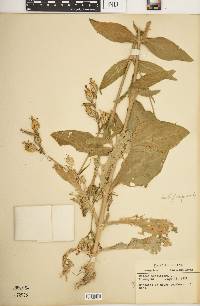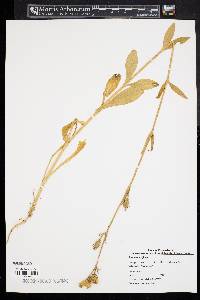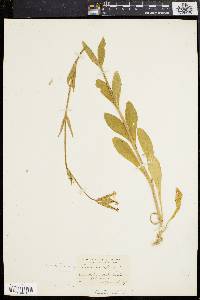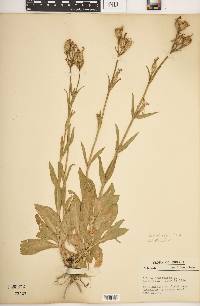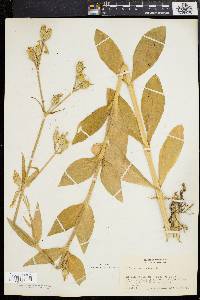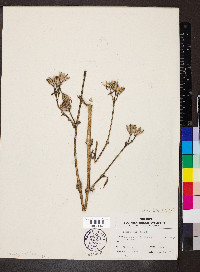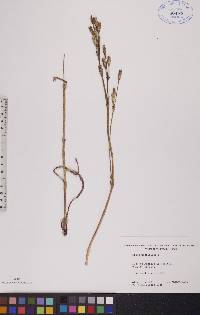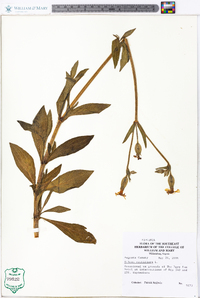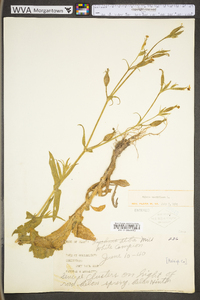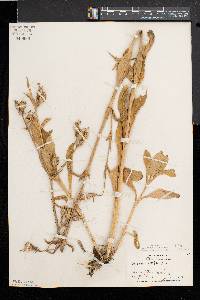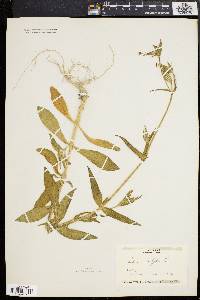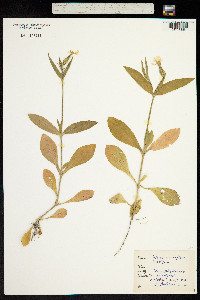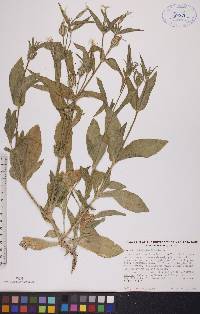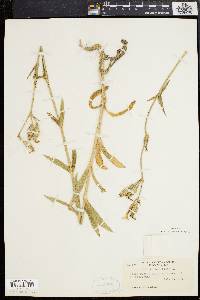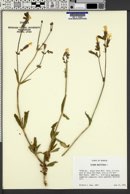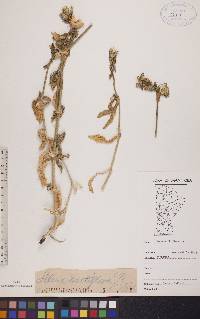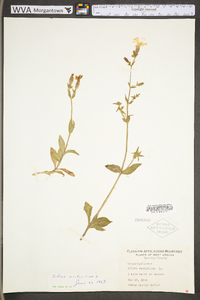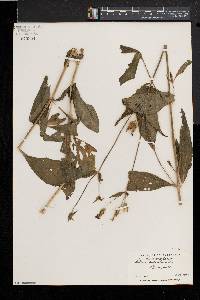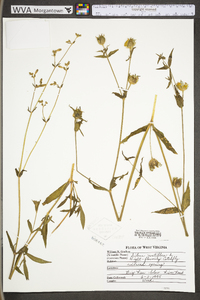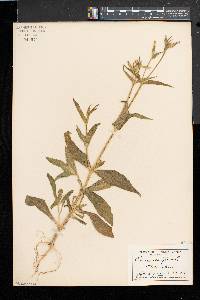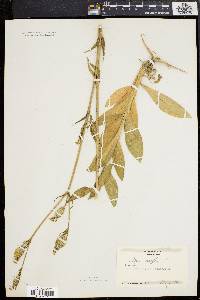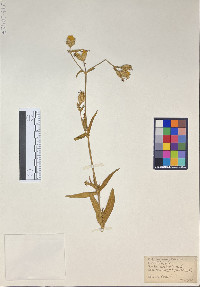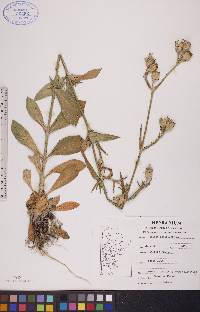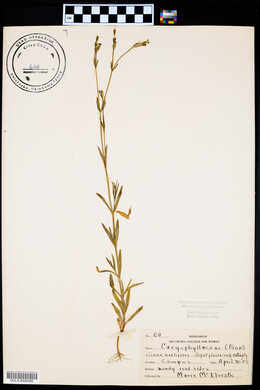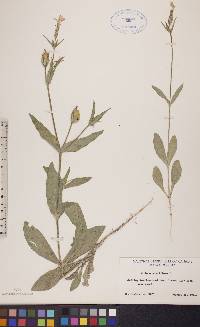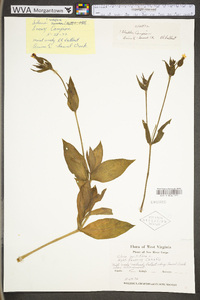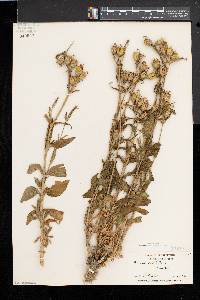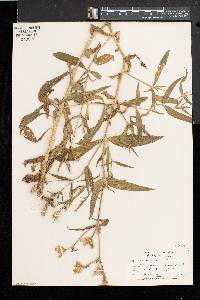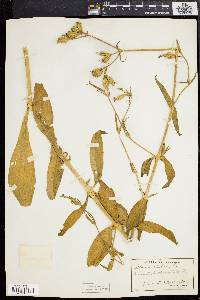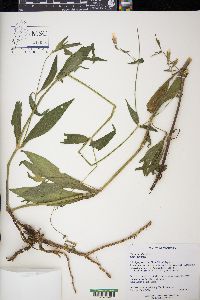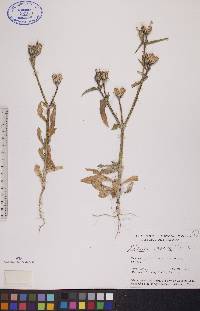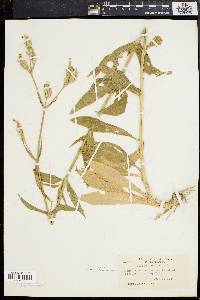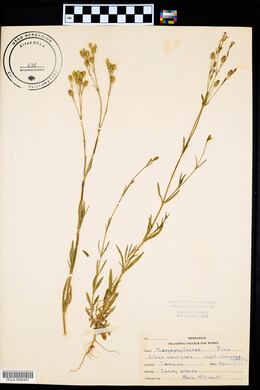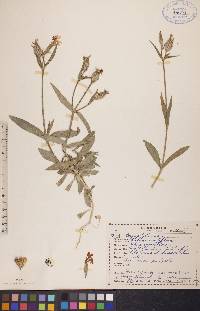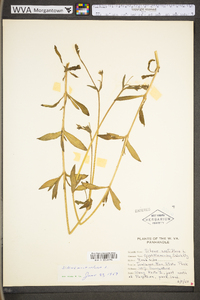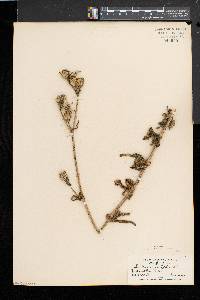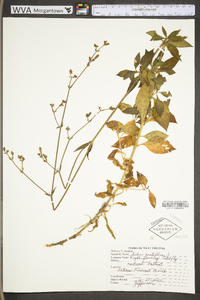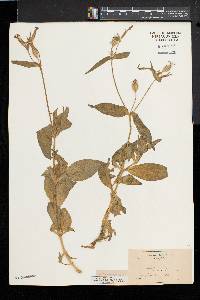Silene noctiflora
|
|
|
|
Family: Caryophyllaceae
Night-Flowering Catchfly, more...nightflowering silene
[Melandrium noctiflorum Fries, moreSilene fortunii Hort. ex Fenzl, Silene orientalis Mill.] |
Plants annual, densely pubescent throughout, viscid-glandular, especially distally; taproot slender. Stems erect, simple proximal to inflorescence or with few basal branches, branched distally, to 75 cm. Leaves 2 per node, gradually reduced distally; basal blades oblanceolate, 6-12(-14) cm × 20-45 mm; cauline blades ascending, conspicuously veined, broadly elliptic to lanceolate, 1-11 cm × 3-40 mm, apex acute, shortly acuminate, densely pubescent on both surfaces. Inflorescences cymose, 3-15-flowered, bracteate; cyme open, flowers held on ascending branches; bracts leaflike, narrowly lanceolate, 1-5 cm, apex acuminate. Pedicels ascending, straight, 1/ 3-3 times longer than calyx. Flowers nocturnal, 20-25 mm diam.; calyx prominently 10-veined, ovate-elliptic, fusiform, narrowed to both ends and constricted around carpophore, 15-24(-40) × ca. 3 mm in flower, swelling to 10 mm diam. in fruit, thin and papery, margins dentate, with pale commissures; lobes erect, often recurved in fruit, linear-lanceolate, long, narrow, (3-)5-10(-15) mm, apex acuminate, short-pubescent, glandular, interspersed with long eglandular hairs, veins anastomosing; corolla white, often pink tinged, clawed, claw equaling calyx lobes, limb deeply 2-lobed, lobes usually narrow, appendages 0.5-1.5 mm broad, margins entire or erose; stamens shorter than petals; styles 3, shorter than petals. Capsules ovoid, constricted at mouth, equaling or slightly longer than calyx tube, opening by 6 recurved teeth; carpophore 1-3 mm. Seeds dark brown to black, with gray bloom, broadly reniform, 0.8-1 mm, strongly tuberculate. 2n = 24. Flowering summer. Arable land, disturbed ground; 0-3000 m; introduced; Alta., B.C., Man., N.B., Nfld. and Labr. (Nfld.), N.S., Ont., P.E.I., Que., Sask., Yukon; Alaska, Ala., Calif., Colo., Conn., Del., D.C., Fla., Idaho, Ill., Ind., Iowa, Ky., La., Maine, Mass., Mich., Minn., Miss., Mo., Mont., Nebr., N.H., N.J., N.Mex., N.Y., N.C., N.Dak., Ohio, Oreg., Pa., R.I., S.Dak., Tenn., Utah., Vt., Va., Wash., W.Va., Wis., Wyo.; Europe. Silene noctiflora is sometimes confused with S. latifolia, but they are very different species. Silene noctiflora differs in having perfect flowers with long, very narrow calyx teeth and an elliptic, fruiting calyx that is narrow at the mouth and constricted around the capsule base. It also has three styles and a capsule that dehisces by six teeth; S. latifolia has (four or) five styles and a capsule that dehisces by five bifid teeth. The flowers of S. noctiflora, as its name indicates, are nocturnal and moth-pollinated.
Annual herb with a slender taproot 20 cm - 0.8 m tall Stem: upright, unbranched below (or with a few branches), branched above, densely hairy, sticky-glandular above. Inflorescence: a loosely branched, open cluster (cyme) of three to fifteen flowers, subtended by bracts. Bracts leaf-like, 1 - 5 cm long, and narrowly lance-shaped with a pointed tip. Flowers: white, often tinged pink, yellowish underneath, 2 - 2.5 cm in diameter. Stalk ascending, longer than the calyx. Stamens ten, shorter than petals. Styles three, shorter than petals. The flowers open in the evening. Sepals: fused at the base into a tube (calyx). Calyx tube 1.5 - 3 cm long, to 1 cm wide (largest in fruit), egg-shaped to elliptic, narrowing at both ends, ten-veined, with five short lobes. Lobes upright 0.5 - 1 cm long, and linear to lance-shaped with a pointed tip, shortly hairy, glandular. Petals: five, white, often tinged pink, yellowish underneath, blade 7 - 10 mm long, narrowly clawed, deeply two-lobed. Fruit: a dehiscent capsule, three-chambered, opening by six recurved teeth, equal to or slightly longer than calyx, egg-shaped, constricted at opening. Seeds brownish black with a grayish bloom, about 1 mm long, broadly kidney-shaped, roughened. Basal leaves: stalked, 6 - 12 cm long, 2 - 4.5 cm wide, reverse lance-shaped, densely hairy. Stem leaves: opposite, two per node, ascending, stalkless, 1 - 12 cm long, 3 mm - 4 cm wide, gradually reduced upward, lance-shaped to broadly elliptic with a pointed tip, conspicuously veined, densely hairy. Similar species: No information at this time. Flowering: July to late September Habitat and ecology: Introduced from Europe. Local in partly shaded waste ground and as a weed in cultivated areas. Also found along railroads. Occurence in the Chicago region: non-native Etymology: Silene probably comes from the Greek word sialon, meaning saliva, referring to the sticky secretion on many of these plants. It may also have come from the word seilenos, referable to Silenus-a foam-covered, drunken character in Greek Mythology. Noctiflora means "blooming at night." Author: The Morton Arboretum Annual, 2-8 dm, densely and coarsely hirsute below, viscid with abundant glandular hairs above; lvs lance-ovate to elliptic-oblanceolate, 5-12 נ2-4 cm, the basal petiolate, the cauline narrower, sessile, infl loosely branched; fls mostly perfect; cal 1.5 cm at anthesis, inflated and 2.5-3 cm in fr, the 10 nerves glandular and freely anastomosing, the lance-linear lobes 5-9 mm; pet blade 7-10 mm long, deeply 2-lobed, pink above, yellowish beneath, inrolled during the day, opening in the evening; auricles 1-1.5 mm, the broad appendages 0.5-1.5 mm, entire or erose; carpophore 1-3 mm; styles 3; fr 3-locular, opening by 6 teeth; seeds 0.8-1 mm, rugose-papillate; 2n=24. Native of Europe, widely distributed as a weed in most of the U.S. and s. Can. July-Sept. Gleason, Henry A. & Cronquist, Arthur J. 1991. Manual of vascular plants of northeastern United States and adjacent Canada. lxxv + 910 pp. ©The New York Botanical Garden. All rights reserved. Used by permission. From Flora of Indiana (1940) by Charles C. Deam This species has been reported from 8 counties as a weed of cultivated grounds and waste places. I have two specimens from open woodland. This species much resembles Lychnis alba with which I think it is often confused. It can be easily separated from it by the following characters. Silene noctiflora has 3 styles, calyx 10-nerved, calyx lobes linear-lanceolate and mostly 4-8 mm long, and a capsule with 6 teeth. Lychnis alba has 5 styles, calyx with 10 strong and 10 faint nerves, calyx lobes triangular, mostly 3-5 mm long, and a capsule with 5 deeply bifid teeth. Specimens can be easily separated at any stage of growth. …… Indiana Coefficient of Conservatism: C = null, non-native Wetland Indicator Status: N/A |

